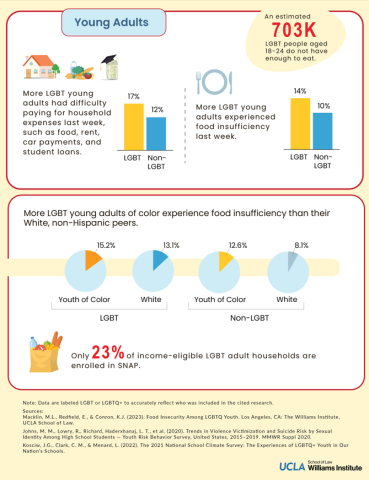Addressing Food Insecurity Among LGBTQIA+ Youth
LGBTQIA+ youth experience higher rates of hunger due to food insecurity when compared to their non-LGBTQIA+ peers. While school meals are a reliable food source for millions of U.S. students, many LGBTQIA+ youth miss school because they feel unsafe or uncomfortable.
LGBTQIA+ youth experience higher rates of hunger due to food insecurity when compared to their non-LGBTQIA+ peers. While school meals are a reliable food source for millions of U.S. students, many LGBTQIA+ youth miss school because they feel unsafe or uncomfortable. In fact, 32% of LGBTQIA+ youth missed school, and 22% avoided the cafeteria due to feeling unsafe.
The LGBTQIA+ population is also under-enrolled in nutrition benefits, with only 23% of income-eligible LGBTQIA+ adult households being enrolled.
These points can be further explored in our full report on Food Insecurity Among LGBTQIA+ Youth and accompanying fact sheets.
No Kid Hungry partnered with the Williams Institute, a leading LGBTQIA+ think tank, to provide this analysis and explore new research on organizations' roles in addressing food insufficiency and promoting economic mobility.


In partnership with the Williams Institute and member-based association CenterLink, data was gathered from 73 LGBTQIA+ youth programs to examine the programs’ experiences and perspectives on addressing food insecurity among LGBTQIA+ youth. Some highlights:
- Older youth ages 18 to 25, transgender youth, and Black and Latinx youth more commonly did not have enough to eat,
- 72.6% of youth programs noted school as source of food for LGBTQIA+ youth (behind community-based organizations, 91.8%, and chosen family/friends, 82.2%),
- Unstable housing was the most frequent reason programs reported for why youth lack adequate access to food (84.9%), followed by lack of access to jobs that pay livable wages (71.2%), family food insecurity (68.5%), lack of family support (63.0%), and transportation barriers (47.9%),
- Only 56.5% of programs mentioned providing eligibility counseling or enrollment assistance for SNAP or WIC as a strategy utilized to increase youth access to food
The strategies viewed as most successful among LGBTQIA+ youth organizations were providing meals and snacks and operating on-site food pantries. These strategies and others must include plans to reduce barriers to access, engage youth, collaborate with external partners, adequate funding and staffing, and a committed organizational culture.
More details about these strategies can be found in the full report The Role of LGBTQIA+ Youth Organizations in Addressing Food Insufficiency.
Continuing the strong partnership with the Williams Institute and new work with the Boston Alliance of LGBTQIA+ Youth, we convened a group of community-based organizations to discuss employment and economic mobility as a means of addressing food insecurity among LGBTQIA+ youth in September of 2023. This report presents findings and recommendations from the convening. Some highlights:
- Stabilization of youth in housing was seen as a critical component of addressing both food and employment needs,
- Government programs, such as SNAP, are typically inadequate to address food insecurity among LGBTQIA+youth,
- Mentorship can be critical in supporting youth to develop problem-solving, employment, and other life skills,
- Inclusive employment is necessary when considering opportunities for LGBTQIA+ youth.
- Capacity, resources, and funding constraints limit what programs can do to support LGBTQIA+ youth, and
LGBTQIA+ youth should be engaged at all levels of a program or organization, including economic stabilization activities.
We also found that participants identified lack of support from a youth’s family of origin as a primary barrier to economic security.
When considering the inadequacy of government benefits, policymakers should examine eligibility criteria for SNAP and other public benefits to assess barriers for LGBTQIA+ youth.
More details on these themes and recommendations can be found in the full report Employment as a Path Towards Greater Food Security For LGBTQIA+ Youth.


